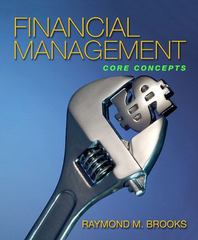Question
Problem 3 (20 pts) Suppose there are many equal-size firms in an industry, ranging from the safest to the most risky firm. However, for computational
Problem 3 (20 pts)
Suppose there are many equal-size firms in an industry, ranging from the safest to the most risky firm. However, for computational ease assume there are only two equal size firms. Each firm needs to raise the same amount of funds ($100 mi.) to start a project. Assume that net revenue is calculated after interest and principal payments have been made. The opportunity cost of lending funds is 10 percent for savers (i.e., the next best alternative for savers will give them net revenue gains of $10 mi. for each $100 mi. invested). Refer to the following information to answer the following questions below:
-
The safe firm is certain that it will see a 30 percent net return on its project (i.e., for each $100 raised, the safe firm will see revenue of $150).
-
For the risky firm there is a 50 percent chance that it will see a 50 percent return on its project (i.e., for each $100 raised, the risky firm will see revenue of $170) and a 50 percent chance that it will see revenue of $90 (i.e., for each $100 raised, the risky firm will see net revenue of -$30).
-
Further assume that savers have an opportunity cost of 20 percent (i.e., there is another opportunity available to savers that will give them revenue of $120 for each $100 invested.
| Industry Conditions | Prob. | Safest Firm-Revenues | Riskiest Firm-Revenues | Market Average | |||
|
|
| Before interest & principal | After interest & principal | Before interest & principal | After interest & principal | Before interest & principal | After interest & principal |
| Economic Expansion | .50 | $150 mi. | $_____ mi. | $170 mi. | $ ____mi. | $____mi. | $____mi. |
| Economic Contraction | .50 | $150 mi. | $____ mi. | $ 90 mi. | $-____ mi. | $ ____ mi. | $____mi. |
|
| E(Rev)= | $150 mi. | $____ mi. | $130 mi. | $____mi. | $____ mi. | $____ mi. |
-
Assuming symmetric information, what will the safe firms profit be for each $100 bond sold to finance the project?
-
Assuming symmetric information, what promised payment will savers require for each $100 bond sold by the risky firm? Will the risky firm in the above example sell any bonds? Why not?
-
Assuming asymmetric information, what promised payment will savers require for each $100 bond sold by either firm? [Use market averages]
-
Under asymmetric information, would either firm end up selling bonds? Explain why or why not.
Step by Step Solution
There are 3 Steps involved in it
Step: 1

Get Instant Access to Expert-Tailored Solutions
See step-by-step solutions with expert insights and AI powered tools for academic success
Step: 2

Step: 3

Ace Your Homework with AI
Get the answers you need in no time with our AI-driven, step-by-step assistance
Get Started


